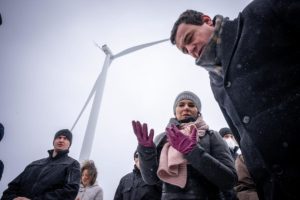After the economic crisis caused by Covid-19 and the energy crisis caused by Russia’s invasion of Ukraine, European unity is being tested once again, this time by the US Inflation Reduction Act (IRA).
When President Joe Biden signed the IRA into law in August 2022, European leaders welcomed the move: at last, Washington was ramping its climate ambition and putting significant resources – no less than US$369 billion – behind it.
However, there was a degree of caution in their praise. European policymakers are concerned that the strong “buy American” component of the IRA will deter investment in clean technologies in the EU, and that companies will set up shop or shift investments to the US to take advantage of the IRA’s generous tax credits.
There have been several rounds of diplomatic talks between Brussels and Washington to mitigate the risks that the IRA poses to European businesses.
Concerns grew last November as an increasing number of cleantech players signalled their interest in relocating from Europe to the US. EU leaders adopted a much more assertive rhetoric on the need to respond to the IRA. This included the European Commission’s industrial policy and internal market chief, Thierry Breton, who advocated for the creation of a “European IRA” and a revamp of the bloc’s industrial policy using “common [European] debt.” The European sectors at higher risk from the IRA include manufacturing of wind and solar energy components, batteries, electromobility, carbon capture and storage, hydrogen, and sustainable aviation fuels.
In perspective, the amount of public funding made available by the European Green Deal, the EU’s flagship climate policy, is still much larger than the IRA, totalling 1 trillion euros of public and private finance in its Green Deal Investment Plan. But “what sets the Inflation Reduction Act apart from any EU investment scheme is that it is predictable, and quick,” Leon de Graaf, a senior consultant at Brussels-based lobby firm #SustainablePublicAffairs, told China Dialogue.
“With the IRA, you know exactly the moment you apply that you will get the financing as long as you tick all the boxes. It is simple and quick, and so we need simple and quick solutions,” he added.
That is the key question that European lawmakers and EU capitals are trying hard to answer: how to stay competitive in the era of green industrial policy, while ensuring fair competition within the EU?
Why EU state aid rules matter
Understanding the importance of the 27-nation bloc’s state aid rules requires a trip back 30 years when the EU’s single market was created. The internal market allows for all goods created in any of the 27 EU member states to be exchanged freely across the bloc, and to compete under the same conditions.
EU state aid rules are meant to ensure there is no unfair competition among the bloc’s member states. If a national government were to grant subsidies to a certain sector it would confer an advantage to producers in that country over those in other EU member states.
“We really need the EU single market, and the effects of a well-functioning single market are as good as state aid,” said the Commission’s competition chief Margrethe Vestager at a webinar on 13 February. “It is really short-sighted to say, well, let’s just put taxpayers’ money in here. Because if we don’t get the balance right, we would sacrifice the single market.”
Now, Brussels and EU countries are at odds as to whether state aid rules should be loosened to grant quicker financial support to the European manufacturers affected by the Inflation Reduction Act.
France and Germany, as well as other nations, including Italy and Spain, have advocated for more flexible and quicker procedures to grant state aid. Many of these EU nations also happen to be those that have granted the most subsidies. Since March 2022, as a result of the energy price crisis, some €672 billion of state aid has been granted, with Germany accounting for as much as 53% of it, followed by France at 24%.

In contrast, the “frugal” EU nations, Nordic countries, the Netherlands, and several central and eastern EU member states, are wary that relaxing state aid rules would only benefit a few EU member states with deeper pockets, and damage competition within the 27-nation bloc. They argue that state aid rules were already relaxed in response to the economic fall-out resulting from Covid-19 and the energy crises.
At the latest EU summit on 9–10 February, EU leaders agreed it was necessary to “allow for targeted, temporary and proportionate support to be deployed speedily… in those sectors that are strategic for the green transition and are adversely impacted by foreign subsidies or high energy prices.” More specific actions on how to respond to the IRA will be discussed at a summit on 23–24 March, following a proposal by the European Commission to present a “Net Zero Industry Act” the week before.
The EU Commission also expects to present a legislative proposal this summer to create a European Sovereignty Fund to support the bloc’s net zero industry transition. The details on the expected fund size and how it’s going to be financed have not been revealed.
Still, there are already some fault lines among EU capitals. Most notable is the possibility that the fund could be financed with common European debt, something that nations including Germany and the Netherlands have strongly opposed.
Open trade
In other words, the EU is now at odds between safeguarding its internal market and maintaining global competitiveness in cleantech manufacturing.
Cleantech for Europe, a trade association of climate investors and clean tech venture capitalists (VCs) on the continent, said that a global “race to the top” was expected to occur regardless of the Inflation Reduction Act.
“The global cleantech race is really core to the successful implementation of the Paris Agreement, and it was always going to be how we were going to reach its ambitious goals,” says Suzana Carp, deputy executive director at Cleantech for Europe.
However, China has consistently outweighed the US and the EU when it comes to cleantech investments. The latest Energy Technology Perspectives report by the International Energy Agency (IEA) is clear: China accounts for some 85–90% of manufacturing capacity expansion plans for solar PV components and offshore wind components by 2030, and over 90% of EV battery components.
Cleantech for Europe said in a report that now, China and the US – as a result of the IRA – have engaged in an “aggressive industrial policy combining subsidies, production incentives and access to finance.”
The global cleantech race puts the EU in another challenge: how to stay competitive globally while continuing to wave the flag of free and open trade.
“The EU’s response is not just a ‘European IRA’, from the point of view that it doesn’t just intend to favour European products, but has open trade as one of its key pillars,” an EU official told China Dialogue. “Nobody wins from protectionism”.








